Understanding CDPs: Key Platforms and Selecting the Ideal Solution
-
UncategorizedUpdatedPosted:
On this page
If there’s one thing that digital companies are moving further and further towards to engage customers, it’s personalization.
After all, everywhere we look, from online shopping to social media platforms, we’re being targeted with information and products we’re promised are tailored to us personally.
And the stats bear out the importance of personalization, too. 71% of consumers feel frustrated when a shopping experience is impersonal, and a further 74% feel frustrated when web content isn’t personalized.
Plus, a whopping 83% of consumers are happy to share their data with companies to get more personalized experiences in return.
But how exactly can you ensure you provide customers with the personalized experiences they deserve?
That’s where CDPs come in.
Don’t worry if it’s your first time hearing of a CDP – we’re about to dive into what they are, how they work, and how to choose the right one.
What Does CDP Stand For?
CDP stands for customer data platform. Not sure what a CDP is in marketing? We’ll talk you through it.
What Is a CDP?

A customer data platform collects customer data from touchpoints through the customer experience, such as website visits, social media pages, email list sign-ups, and any other place where a consumer interacts with a company.
Using this insightful data, companies can not only get an idea of the demographics they most appeal to but also build a profile of their loyal customers. These profiles allow businesses to deliver more personalized experiences, ensuring customers feel valued.
They’re also an easy way of keeping key customer data all in one place, meaning various team members can access this crucial data at any time.
CDP VS CRM?
CRM stands for customer relationship management and is another tool used to store, manage, and use customer data.
CRMs and CDPs are undoubtedly similar, but key differences exist. A CRM tends to store salesperson-related data, e.g., outbound emails sent and phone calls made. B2B companies typically use these tools.
Another difference is in the input. Typically, salespeople will input the data into CRMs themselves. With CDPs, however, the data tends to come from automated systems, tracking, APIs, etc.
CDP VS DMP?
A DMP is a data management platform, and they’re typically used to build the profiles of anonymous users. A DMP targets the top of the funnel by managing unknown site visitors or users. A CDP, on the other hand, focuses on known or identified customers.
While the line has become more blurred with tech giants like Apple limiting third-party tracking, there’s still a key difference between the purpose of these two management systems.
Why Do CDPs Exist?
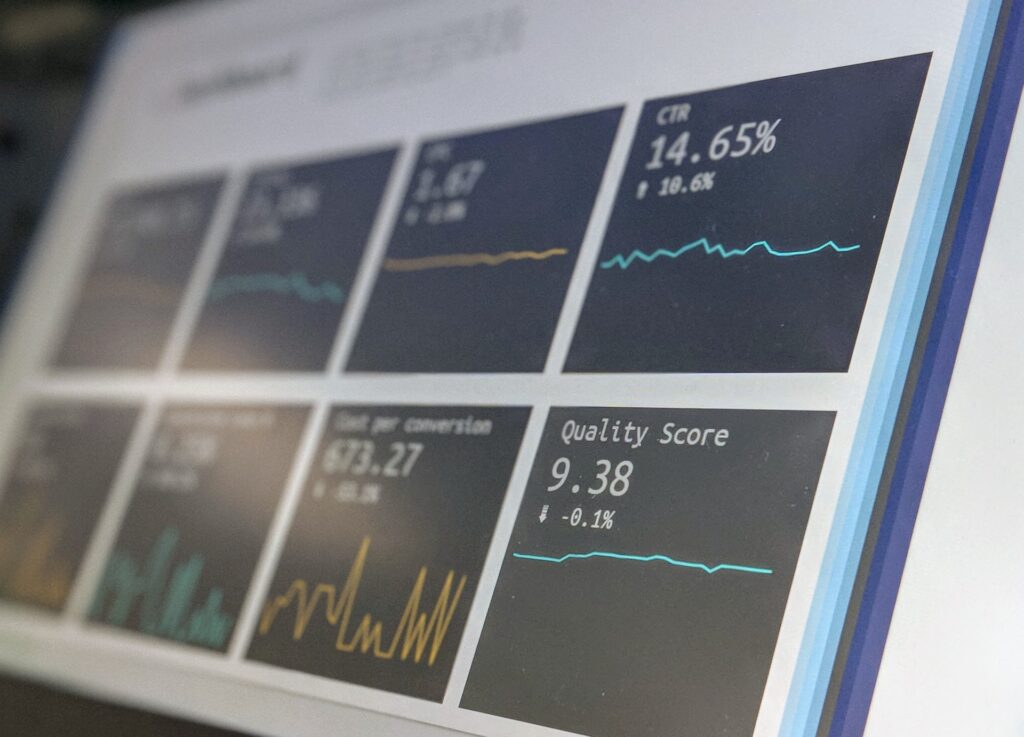
There are plenty of reasons a company might benefit from introducing CDPs.
For one, they avoid data silos, which is when data is only available to one section of an organization and not others.
CDPs allow important customer data to be stored in a centralized space so everyone, from product managers to product marketers, can access these insights.
Another one of the key reasons CDPs exist is to make personalization easier.
With everything from Amazon recommendations to TikTok videos being tailored based on our previous interactions, customers now actively expect personalization in all their interactions – it’s no longer just an added bonus.
80% of consumers are more likely to do business with an organization that delivers tailored experiences, so the importance of prioritizing this personal approach can’t be overstated.
Once you have that useful data, you can use it not only to build customer profiles on an individual basis but also to get an insight into the overall demographics.
It’s a great way of gathering first-party data, too, which is when you receive data directly from your customers.
What Are the Key Features of a CDP?
Wondering what exactly a CDP does? Here are some key features you’ll find in most CDP tools.
Ways to collect user data
The first (and arguably most important) task of a CDP is to collect customer data from sources such as social media and the information customers give on sign-up forms and the like. APIs can track on-site and in-app behavior, while integrations with SaaS tools and platforms can allow you to further supplement the data.
As well as customer attributes, a CDP can collect data on events, actions, behavior, transactional data, and campaign metrics.
Ways to identify and manage data
Data isn’t just valuable by itself – it forms patterns, too. CDPs are great at collecting data from various interactions and collating them to form useful customer profiles of each individual, which can form the basis of bang-on personalized experiences.
A place to store the stitched data
CDPs provide one centralized space, accessible by all teams, where this useful data can be stored.
Ways to send the stitched data to downstream tools
Many CDPs integrate with tools that can put this data to good use, such as customer engagement platforms.
What Types of CDPs Are There?
CDPs aren’t all created equally – here are the differences between them.
Proprietary
A proprietary CDP has all of the above features in one handy platform, like Salesforce or Segment. These platforms require little set-up or technical know-how and may be more expensive/less customizable.
Warehouse-native
With a warehouse-native CDP, you’ll find that it can collect and identify data and send it downstream. However, you’ll have to connect to a customer-managed database or data warehouse to store the data. Rudderstack is an excellent example of this type of CDP.
Composable
With a composable approach, you might decide to purchase a different CDP for each step of the data collection and management journey. You can build a best-of-breed stack by purchasing tools that are great at each individual feature – as the name suggests, you’re literally composing your own ideal CDP.
For collecting data, for example, you might choose Snowplow. Stitching data works best with tools like Snowplow and Rudderstack, while Snowflake and Redshift are great for storing data. For sending data to downstream applications, look to Hightouch or Census.
What are the most common CDP use cases?
While CDPs can be used for all kinds of business activities and processes, there’s already a range of common use cases we’re seeing across multiple industries. It’s well worth getting to know these cases since they can help you identify how to best implement CDP in your own business.
- Profile Unification: CDPs are experts in amalgamating customer data records into a single, 360-degree view. This unification makes personalization more effective, and helps reduce redundant ad spending.
- Segmentation: The platform also allows marketers to identify and target high-value audiences with advanced segmentation capabilities. Meaning, you can draw out meaningful clusters from your customer base and personalize your campaigns for each, improving campaign results by leaps and bounds.
- Data Unification: Another thing CDPs do really well is to unify customer data and create a single customer identifier. This process enriches the customer profile progressively, and decreases duplications and inaccuracies.
- Predictive Scoring: CDPs come armed with the power to predict customer behavior. They can sort out who is most likely to churn, make a purchase, click a link, or convert. This predictive scoring ability greatly enhances marketing effectiveness.
- Retargeting: With CDPs, you can make your retargeting efforts more effective by connecting customer data to advertising data. This creates optimized audience segments and automates activations, making the most of your ad spend.
- Customer Journey Optimization: CDPs provide iterative insights that allow quick testing, learning, and improvement of marketing efforts across the entire customer journey. This feature is a great way to ensure you are making data-driven decisions about your customer interactions.
- Customer Loyalty: CDPs give you the tools to measure and predict customer loyalty effectively. You can then customize communication to increase the lifetime value of your most loyal customers. After all, repeat customers are often the most profitable.
- Data-Driven Marketing and Advertising: With a single, unified view of the customer, data-driven marketing and advertising become much more feasible. You can leverage this to deliver highly personalized experiences that resonate with each individual customer.
- Programmatic Advertising: CDPs also enable better targeting in programmatic advertising. You can target customers more accurately and effectively, resulting in higher engagement and conversion rates with your ads.
So, these are some of the many ways CDPs prove to be indispensable in modern marketing. With tons of data pouring in every minute, you need a smart, efficient, and powerful tool to make sense of it all – and CDPs are just that.
Who Needs a Customer Data Platform (CDP)?
Let’s be real – understanding customers and using their data effectively is super important these days. With all the amazing loyalty-boosting benefits of CDPs, marketers of all levels can really up their game with one.
But you’re probably wondering – who exactly gets the most out of these things? Great question.
There’s a few key players who would really level up with a CDP:
Chief Marketing Officers (CMOs)
For CMOs, the pressure is on to hyper-personalize experiences, track ROI, and really understand the customer journey. With a CDP bringing all that customer data together in one place, they can kick their campaigns into high gear for more conversions and happier customers. Win-win!
Senior Vice Presidents (SVPs)
The big strategic decisions fall on the shoulders of senior execs. Having a CDP gives them the insights they need to make the right calls for the organization. From planning huge marketing campaigns to weighing the impact of different strategies, a CDP gives them a data treasure trove to work their magic.
Marketing Directors
These folks have their hands full overseeing and coordinating marketing. A CDP makes their job way easier by unifying customer data in one spot for planning campaigns, tracking success, and tweaking as needed.
But it’s not just specific roles that crush it with CDPs – they work wonders across industries and business models:
B2C Brands
For consumer brands, personalizing experiences across channels and delivering seamless customer journeys can skyrocket engagement, conversions, and retention. CDPs help make it happen.
B2B Brands
Even B2B companies can level up with unified customer data from a CDP. It takes their lead scoring, predictive analytics, ABM strategies, and long sales cycle management to the next level. Business growth, here we come!
The bottom line?
Anyone who needs customer data to make good decisions will love having a CDP. Companies can really understand their customers, make smarter choices, and create personalized marketing with one.
Who Are the Big Players?
While not the only kids on the block, here are some of the biggest names in customer data collection.
Segment
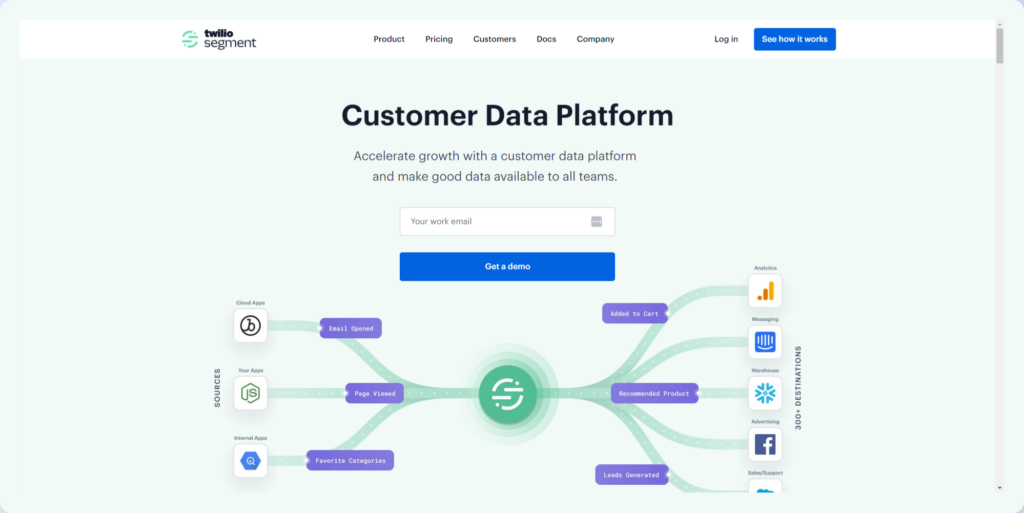
New to CDPs?
Segment is a great option. It’s perfect for businesses wanting a proprietary CDP that does it all. Its Team Plan allows you to pull in data from unlimited sources and send it to unlimited destinations, but there’s a free trial option, too, if you want to give it a go without committing.
Rudderstack
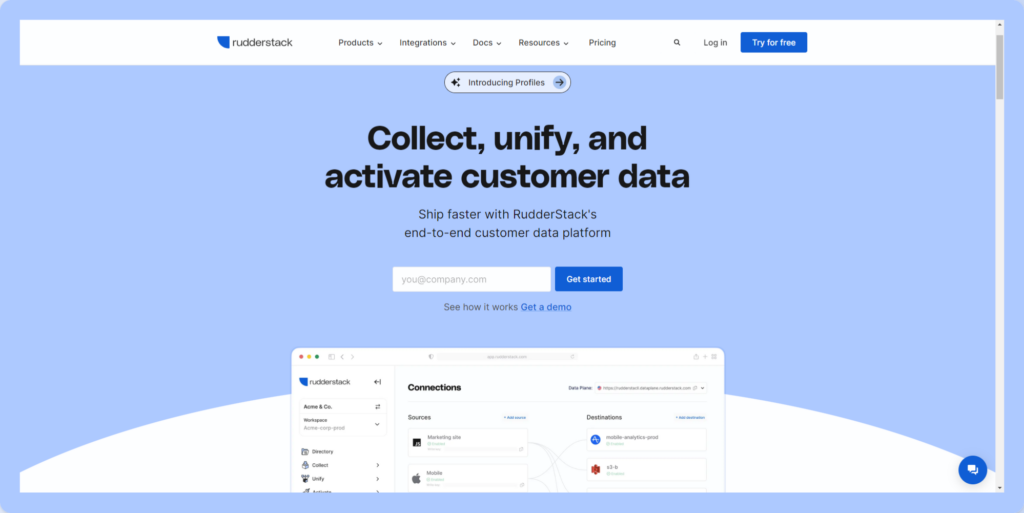
Rudderstack is an open-source platform, meaning the source code is freely available and can be distributed and modified by its users. It’s great for teams with a bit of technical know-how and is an example of a warehouse-native CDP.
Used by big players such as Hinge and Glassdoor, Rudderstack is custom-built for technical data teams and engineers, so it’s probably not as suitable for start-ups with small non-technical teams.
Snowplow
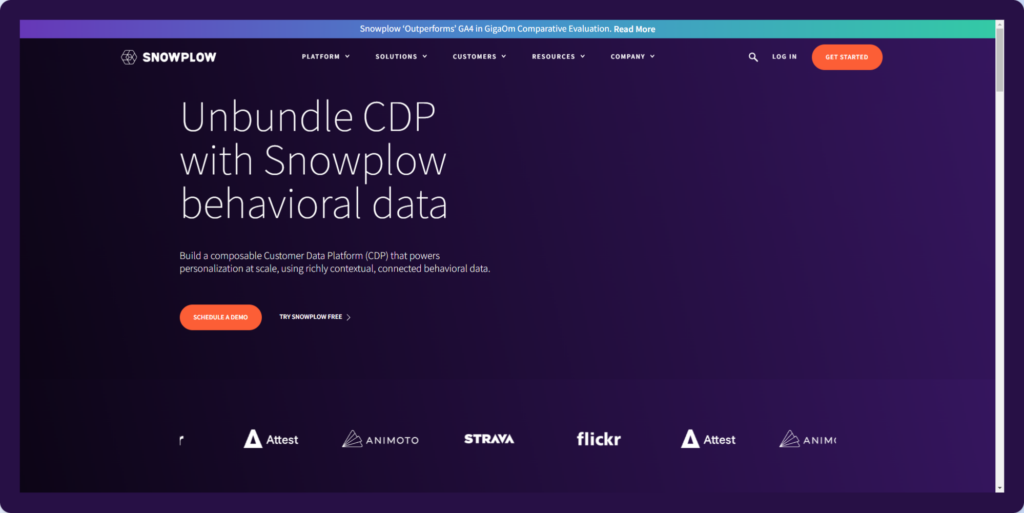
Snowplow works best when integrated with other tools from the stack as part of a composable CDP. It works well at stitching and collecting data. Like Rudderstack, Snowplow has an open-source architecture, so it’s ideal for companies with a robust technical team.
Hightouch
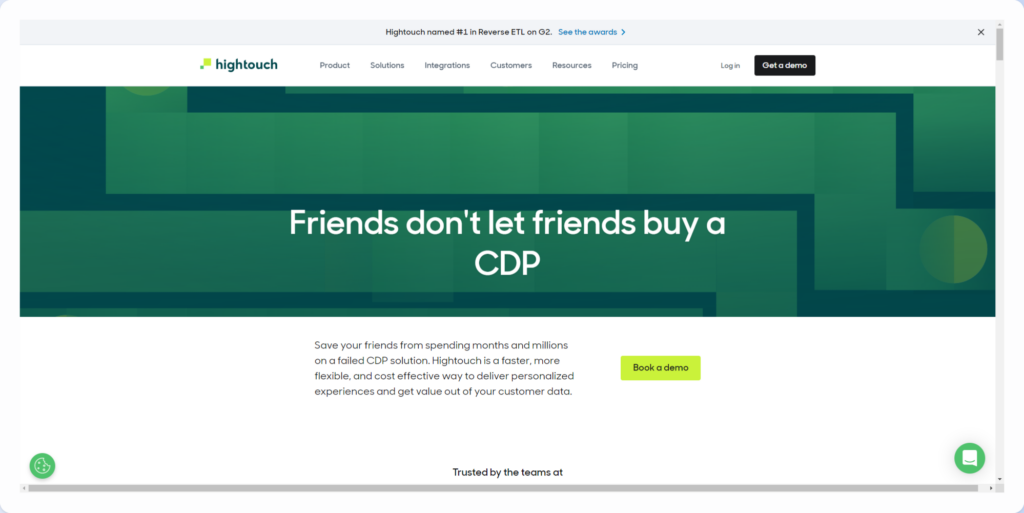
If you plan on syncing your data to downstream tools, Hightouch is ideal. It syncs data in minutes to tools such as your CRM, email, and marketing tools, with no manual work or engineering required.
Census
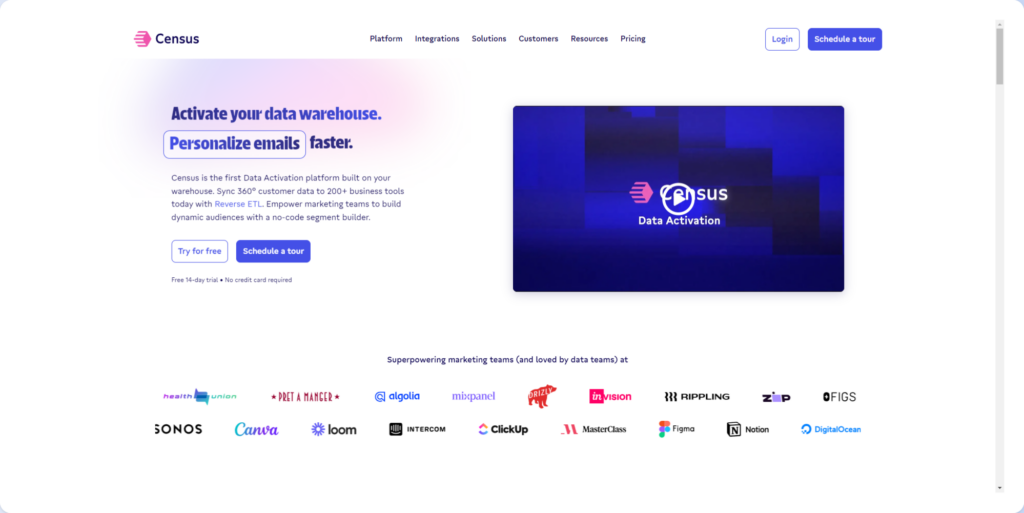
Census is another CDP that allows you to sync your data warehouse to the apps and platforms you use most. It’s ideal as part of a composable CDP when used alongside others who excel in their field.
Snowflake/AWS Redshift/BigQuery/Azure Synapse
These CDPs provide optimized data storage. Snowflake is one of the biggest names in this part of a composable CDP, promising to eliminate data silos and optimize architecture so you can get as much value as possible from your data warehouse.
Salesforce
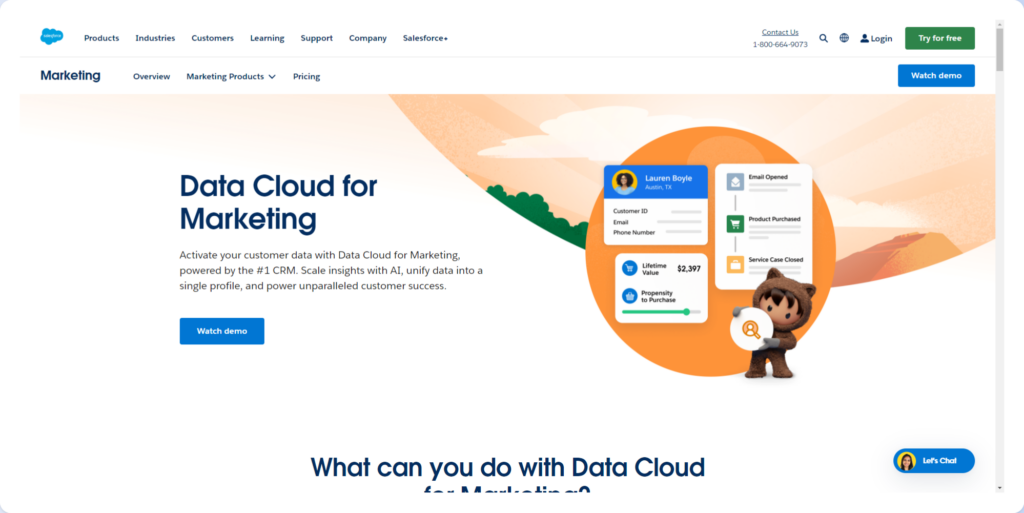
Salesforce has been historically seen as a CRM, but it boasts CDP capabilities thanks to the Data Cloud that continuously updates your customer data, making it easier than ever to provide personalized experiences. Salesforce is an excellent option for teams looking for an end-to-end solution that requires minimal technical intervention.
What Should You Do With Customer Insights?
So, you’ve gathered crucial data about your audience, created customer profiles, and gained a better understanding of consumers. Now what?
You’ll actually need to push ideally timed personalized messages out to your customers based on the data you’ve gathered. Luckily, that’s what Vero is for.
With all your competitors fighting to tailor their experiences in this personalization-first world, standing out from the crowd is a must.
Cut the copy-and-paste approach and prevent churn with the right messages, sent at the right time to the right person with marketing software that truly converts.
If you’re ready to start seeing results, sign up for free today or see what we’re all about first with a demo.
Want to send more personalized mobile and email messages to your users?
Learn moreCustomer story

How UNO uses email marketing from the data warehouse to deliver personalized mortgage broking
